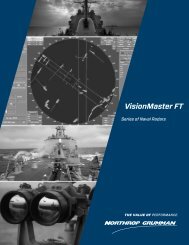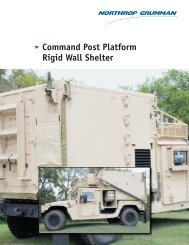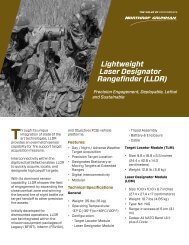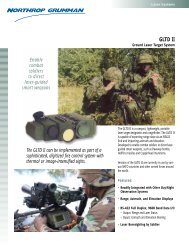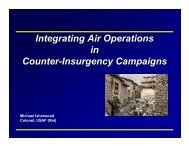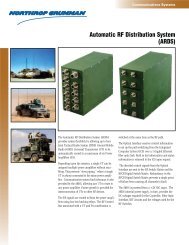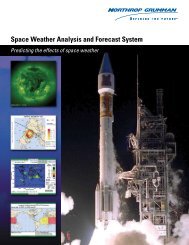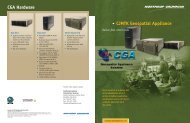[x] amendment of solicitation/modification of contract - Northrop ...
[x] amendment of solicitation/modification of contract - Northrop ...
[x] amendment of solicitation/modification of contract - Northrop ...
Create successful ePaper yourself
Turn your PDF publications into a flip-book with our unique Google optimized e-Paper software.
CONTRACT NO.N00178-04-D-4091DELIVERY ORDER NO.FG02AMENDMENT/MODIFICATION NO.13PAGE5 <strong>of</strong> 42FINALSECTION C DESCRIPTIONS AND SPECIFICATIONSPerformance Work Statement (PWS)USTRANSCOM ANALYTICAL JOINT ANALYTICAL OPERATIONS PROGRAM (JAOP) AND ADAPTIVE PLANNING AND EXECUTION(APEX) SUPPORTPART 1GENERAL INFORMATION1.0 IntroductionThis Performance Work Statement (PWS) supports two tasks. Task One combines the United States Transportation Command’s (USTRANSCOM’s) requirements tosupport the Joint Distribution Process Analysis Center’s Programmatic & Operational Analysis Mission, the Analytic Baseline Mission and the Adaptive PlanningMission. Task Two is for USTRANSCOM, United States Forces, Korea (USFK), and United States Pacific Command (USPACOM) to assess South Korea’s Non-Combatant Evacuation Operations (NEO) plan as it relates to planned and available infrastructure use and it’s capability to effectively support NEO operations.1.1 BackgroundUSTRANSCOM’s mission is to provide global air, land, and sea distribution for DoD both in time <strong>of</strong> peace and in time <strong>of</strong> war through its Transportation ComponentCommands (TCCs): Air Mobility Command (AMC), Military Surface Deployment and Distribution Command (MSDDC), and Military Sealift Command (MSC).USTRANSCOM’s Joint Distribution Process Analysis Center (JDPAC) provides the command’s analytical capability and is the command point <strong>of</strong> contact for mobilityModeling and Simulation (M&S) and deployment and distribution analysis. The Operations and Plans Directorate TCJ3 is the focal point for Adaptive Planning andExecution (APEX) Support. The USTRANSCOM approved models, simulations, and tools used to support the analysis mission include: the Model for Inter-theaterDeployment by Air and Sea (MIDAS), the Joint Flow and Analysis System for Transportation (JFAST), the Joint Integrated Campaign Model (JICM), the EnhancedLogistics Intra-theater Support Tool (ELIST/CONUS-ELIST), the Analysis <strong>of</strong> Mobility Platform (AMP) and its component models, the Mobility Simulator (MOBSIM),the Combined Mating and Ranging Program (CMARP), the JDPAC Quicklook Tools, the Supply Chain Guru (SCG) Distribution Model, the Joint Mobility ClosureEstimator (JMCE), and other resident tools and s<strong>of</strong>tware, such as the Time Phased Force Deployment Data (TPFDD) Editor (ETEDIT), the OpenMap TM mappingtool, and the Airlift Loading Model (ALM).PROGRAMMATIC & OPERATIONAL ANALYSIS (TASK ONE): Programmatic analysis supports Joint Collaborative Analysis with the Joint Staff, OSD CostAssessment Program Evaluation and the COCOMs. Analyses will be as directed by OSD, the Commander USTRANSCOM or the Director <strong>of</strong> the JDPAC. Analyseswill be accomplished using operations research commercial best practices with commercial <strong>of</strong>f the shelf models and simulations and with USTRANSCOM developedmodeling tools. Operational Analysis will support the Operations Directorate analyzing distribution issues on a global basis when TCJ3 organic analytical resources areinsufficient numerically or academically.ANALYTIC BASELINE AGENDA (TASK ONE): Analyses consist <strong>of</strong> support for the Analytic Baseline Study (Future) and includes the Operational Availability (OA)series <strong>of</strong> studies and support for the Multi-Service Force Deployment (MSFD) development process.The Analytic Baseline Study (Future) will determine the force closure and throughput capabilities and requirements to support the AB scenarios for the future. This will bea multi-year task in collaboration with the Joint Staff and OSD. Modeling and simulation and operations research support is required.The OA series <strong>of</strong> analyses supports the Major Contingency Operation MSFD scenarios to determine the impact <strong>of</strong> mobility assets on force closure, sustainment and thewarfight.ADAPTIVE PLANNING AND EXECUTION (TASK ONE): The mission <strong>of</strong> USTRANSCOM J3-G/X, War Planning Teams, is to provide transportation analysis andintermodal planning support and coordinate customer requirements during the adaptive planning process to ensure efficient utilization <strong>of</strong> the Defense TransportationSystem. Planners are involved in reviewing and implementing Strategic Guidance documents/tools, such as the Contingency Planning Guidance (CPG), the Joint StrategicCapability Plan (JSCP) and all associated supplements. In addition, planners participate in the review and development <strong>of</strong> Defense Planning and Multi-Service ForceDeployment (MSFD) scenarios. Planners support all transportation analyses for all Combatant Commands, both geographical and functional. Planners have a criticalrole in the Joint Quarterly Readiness Review (JQRR) as they validate force closure and risk mitigation. Planners are involved in both the Adaptive Planning Road Map aswell as Global Force Management (GFM) for mobility forces. Planners coordinate and route staff correspondence up to the General/Flag Officer (GO/FO) level.Personnel support and advise enlisted Information Technology (IT) personnel, <strong>contract</strong> personnel, government civilians, as well as commissioned <strong>of</strong>ficers from all servicesduring Force Flow Conferences. Planners lead joint planning teams, execute the military decision making process and write supporting plans in JOPES Volume II formatfor JSCP directed plans.ANALYTICAL JOINT ANALYSIS OPERATIONS PROGRAM (JAOP) SUPPORT (TASK TWO): USTRANSCOM, USPACOM, and USFK discussions haveresulted in the recognition that there is a lack <strong>of</strong> adequate end to end analysis in addressing South Korean Non-Combatant Evacuation Operations. This has becomeincreasingly more important as the Japanese have requested NEO numbers for their preparations for receiving refugees. Therefore, an end to end analysis is necessary toassess South Korea’s NEO plan as it relates to planned and available infrastructure use and its capability to effectively support NEO.1.2 PurposeThe purpose <strong>of</strong> Task One is to provide <strong>contract</strong>ed advisory and assistance services (CAAS) to USTRANSCOM’s analytic mission in supporting the analytic baselineand adaptive planning study requirements.The purpose <strong>of</strong> Task Two is to provide CAAS for support <strong>of</strong> USTRANSCOM, USFK, and USPACOMs’ mission to assess South Korea’s NEO plan.1.3 ObjectivesThe Contractor shall provide all staffing, equipment, and materials necessary to perform the tasks as defined in this PWS; except that which is specified in Part 3 asGovernment Furnished Information, Facilities, Property, Equipment and Services. In this requirement, the Contractor shall provide strictly non-personal services and shallwork as an independent <strong>contract</strong>or not subject to the supervision and control <strong>of</strong> the Government.The Contractor shall support USTRANSCOM key missions and issues by providing mobility analytical and technical modeling and simulation and operations researchsupport for the Analytical Baseline effort to include all major DoD collaborative programmatic studies and analyses, deliberate/adaptive planning, wargames andexercises, mobility analyses, collaborative analyses with the COCOMs and, during contingency operations, provide operations research analytical skills to support


![[x] amendment of solicitation/modification of contract - Northrop ...](https://img.yumpu.com/51622731/7/500x640/x-amendment-of-solicitation-modification-of-contract-northrop-.jpg)
